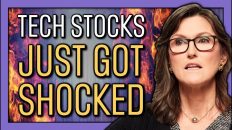Mentioned in Video:
- 🤩 TOP 9 High Growth Stocks to Buy the Dip for 2022: https://www.youtube.com/watch?v=OcmxpmseE8k
- 💥 Are Growth Stocks Dead? My Investing Plan for 2022: https://www.youtube.com/watch?v=66ydXP9ii1o
- CNN's Fear & Greed Index: What emotion is driving the market now? https://money.cnn.com/data/fear-and-greed/
- AAII Investor Sentiment Survey: https://www.aaii.com/sentimentsurvey
- Inventory Pileups, the Latest Employment Report, & ARK Strategies | ITK with Cathie Wood (ARK Invest): https://www.youtube.com/watch?v=mGw4P72d7Bc
- Support the channel and get extra member-only benefits by joining us on Patreon: https://www.patreon.com/tickersymbolyou
⚠️ From #ARKK to ARKX, all 6 #ARKInvest funds keep going lower. The lower growth stocks go, the more confidence #CathieWood seems to have in them. What's going on?! In this episode, I answer your most common questions about the sharp drops in some of the best stocks to buy now, like Tesla stock (TSLA), Teladoc stock (TDOC), and other top @ARK Invest positions.
Video Transcript:
00:00
Holy moly, the end of the year sell-off has been absolutely wild so far. The fear and
00:04
greed index is now showing extreme fear and bearishness is at a record high for the year.
00:09
As the broader market continues to panic sell, I've been getting tons of questions on every
00:13
episode, as well as on Twitter, on Discord, and on Patreon. I'm really grateful that so
00:18
many people are reaching out and asking questions instead of straight-up panicking and acting
00:22
on emotion. That already makes you a better investor than most, including most fund managers,
00:27
who are panic selling to pad their end-of-the-year performance numbers. Seriously, seeking answers
00:33
is exactly what you should be doing in times like these. So, I spent the weekend reading
00:38
through and organizing all of your questions, and I'll be answering them in this episode.
00:41
I'll throw in every quick tip I can think of to give you every edge I feel I have from
00:46
doing this full time. These kinds of Q&A sessions are usually exclusive to the hundreds of people
00:51
supporting the channel as patrons on Patreon and channel members right here on YouTube,
00:56
so if you're one of my supporters, thank you so much. Your awesome support makes this extra
01:00
content possible and it means even more to me knowing your own portfolios are probably
01:05
hurting right now. Since this one is getting posted publicly, I'll do another member-exclusive
01:10
Q&A later in the month for you. And for everyone else, as always, I'm not a financial advisor
01:15
and nothing I say here is ever financial advice. Your time is valuable, so let's get right
01:20
into the questions.
01:21
The first and most basic set of questions I've been getting is: what should I do right
01:25
now?
01:26
The answer is that you should learn how to read the market. Warren Buffett famously says
01:30
that you should be fearful when others are greedy and greedy when others are fearful.
01:34
How do you know when others are being greedy or fearful? Well, if you go check out CNN's
01:39
Fear and Greed Index, you'll see that we're in extreme fear terrority. That article explains
01:44
all of the factors they use to arrive at that number. For example, when people flee to safety,
01:49
the demand for bonds goes up. As the S&P500 draws down toward its 125-day moving average,
01:55
people become more worried it will crash. There are a lot of other indicators on this
01:59
list that serve as a great introduction to understanding what the heck is actually going
02:03
on at a high level. At the end of this list, CNN also shows you how the Fear and Greed
02:09
index has changed over time. Today, it's very low, indicating extreme fear. Here's my extra
02:15
tip for you: sentiment isn't the only thing that moves the market. Change in sentiment
02:20
also moves it. People switched from extreme greed to extreme fear very quickly this time,
02:26
which is why we're seeing such a large sell-off in the riskiest assets — the exact stocks
02:31
and cryptocurrencies I focus on. Another place to track this is the AAII sentiment survey,
02:38
which updates weekly and shows the ratio of people with a bullish, neutral, or bearish
02:43
market outlook over the next 6 months. According to the latest survey, bearishness is at a
02:48
yearly high and bullishness has been steadily trending down all month. I recommend you bookmark
02:53
both of these websites, which I've linked in the description below. When I see the market
02:58
getting to extreme fear territory, I start PREPARING to be greedy. I add cash to my brokerage
03:04
accounts. I catch up on all of my highest conviction stocks. I organize my watch list.
03:08
All the same things I've been saying for the last few weeks. That brings us right to the
03:13
next question.
03:14
How do I decide when to buy a high conviction growth stock versus putting more money into
03:18
a cash-like position?
03:20
So, the first thing I look at when I decide to put any money into the market is this fear
03:25
to greed index. The next thing I check is market volatility, which is one of the components
03:29
of this fear and greed index. The VIX, ticker symbol V I X, is a forward-looking measure
03:35
of the volatility of the market, specifically the S&P 500. How can it be forward-looking?
03:41
It looks at options on the S&P500 with near-term expiration dates. That means it's literally
03:47
just another gauge of sentiment, but more near-term, and only from people with money
03:51
on the line; the ones buying those options. When the VIX is below around 12ish, the market
03:57
isn't expected to be too volatile in the near term. When the VIX is between 12 and 20, normal
04:03
market volatility is expected. When the VIX is above 20 or so, people buying options think
04:08
the market is going to be very volatile and prices might change very fast. Here's my extra
04:13
tip for you here. In addition to the VIX, I track the VXN, ticker symbol V X N. This
04:19
is the same exact thing except it's for the NASDAQ instead of the S&P500. The VXN is a
04:26
better indicator for the stocks I focus on since the NASDAQ is filled with tech stocks
04:30
specifically. It's also A LOT more volatile, which means I end up being much more conservative
04:36
in when I decide to buy. Here's exactly how I use these indicators. When people are getting
04:42
more fearful and volatility is high, I put my money in my cash-like positions or straight
04:48
up leave it in cash. To me, cash-like positions are companies like Google and Facebook, and
04:53
Microsoft. I have literally never ever regretted holding these companies over long periods
04:58
of time. But when volatility is too high, even these stocks can come down; that's when
05:04
I stick to cash. I'm literally at around 50% cash right now. When I see volatility coming
05:10
down and the fear and greed index moving back toward greed, I tend to move more of my money
05:15
into my high conviction growth stocks. Let me know in the comments below whether that
05:19
makes sense to you or if I should clarify any of that. I'm excited to hear what you
05:23
think. Alright, let's keep things moving with the next question.
05:27
With everyone panic selling at once, prices are coming down very fast. Should I buy in
05:31
all at once or slowly average in?
05:34
In my personal, non-professional experience, I've never regretted slowly averaging in or
05:40
out of a position and have almost always regretted buying or selling all at once. For example,
05:45
I started my $100,000 portfolio project in October, so just 2 months ago. Imagine how
05:51
silly I'd look if I spent all my money at once, only to have all my stocks drop by like
05:57
40% just a few weeks later. Here's another example: a few of my friends just bought ARKK
06:02
at $99 dollars a share. That's a great price, but ARKK is now $95. Whoops! So, instead of
06:08
trying to catch a falling knife, I do exactly what I've said before: I get my cash ready
06:13
and keep my watch list and portfolio organized. For each high conviction stock, I catch up
06:19
on the latest earnings reports at a bare minimum, but usually, I'll listen to the whole earnings
06:24
call and see what ARK Invest and my favorite YouTubers are saying about these stocks as
06:28
well because they often catch something I missed myself. Then and only then do I look
06:34
at the price charts for the stock specifically and decide if I want to buy and at what price.
06:39
That brings me to the next question.
06:42
Since many of the companies I look at are unprofitable, what metrics do I use to value
06:46
a company?
06:47
Long story short, the two metrics I care about most are the EV to EBITDA ratio, which I'll
06:51
probably do an entire video on at some point, as well as the price to sales ratio, which
06:56
I use instead of price to earnings since many of the companies I invest in… don't have
07:01
earnings. Yet. I hope. Here's a good rule of thumb for price-to-sales for software-like
07:08
companies. Take the forecasted 3-year compound annual growth rate of a company's revenue
07:13
and cut it in half. That's the price-to-sales multiple you'd probably be willing to pay.
07:18
Again, this ONLY applies to software-like growth companies like the ones my channel
07:23
focuses on, so don't go using it everywhere. If that just sounded like a bunch of mumbo
07:30
jumbo to you, no problem. Let's work through it, using Stone as an example since they literally
07:35
just gave us this number in their most recent quarterly earnings report. The current 3-year
07:39
compound annual growth rate of Stone's total revenue is 53%. Wow. Very high. Let's say
07:45
I expect 40% over the next 3 years, even as they launch new products and services and
07:53
acquire more customers across more verticles. 40 divided by 2 is 20 – that's the price to
07:58
sales I'm pretty happy to pay. Stone is currently trading at a price to sales ratio of 11, far
08:06
less than 20. It's trading at a lower price to sales ratio than Microsoft right now, which
08:11
is one of my cash-like positions. When I made my first episode on Stone stock, it was trading
08:16
at a price to sales ratio of, you guessed it, around 25, which is half of their 3-year
08:22
revenue growth rate. That's what it means to be a data-driven investing channel. I honestly
08:28
don't work too hard to find crazy stocks from every market sector like I used to. Instead,
08:32
I've built one system of indicators and metrics that works for one pretty small set of stocks
08:38
and I stick to that set, which are mostly software-oriented high-tech growth stocks.
08:44
That leads us right into the next question.
08:46
What stocks am I watching the most right now?
08:49
I recently made an episode called Top 9 High Growth Stocks to Buy for 2022, which is my
08:55
answer to this exact question. I'll leave it in the top right-hand corner of your screen
08:59
right now and in the description below as well, along with all the other indicators
09:03
and resources that I talked about earlier. The follow-up question I got the most on that
09:08
episode was: Am I still confident in Tesla, Teladoc, Zoom, Pinterest, Ginkgo Bioworks,
09:14
Palantir, Mercado Libre, Wejo, and every other company I didn't mention in that episode?
09:20
The answer to that is yes, definitely, unless I specifically said otherwise. The point of
09:24
that episode was to give investors different growth stocks at varying levels of risk, from
09:29
relatively low-risk ETFs with 40 stocks all the way up to Stone, which is a risky stock
09:35
in a risky market in a risky part of the world. For example, at the time of this recording,
09:40
Teladoc is trading at a price to sales ratio of 8 and Mercado Libre is trading at under
09:45
9. Those were the next 2 companies to make that list, but I wanted to keep that episode
09:50
fairly short and sweet. I actually bought some shares of Zoom and Teladoc while making
09:54
this episode, even though they weren't on that list. So, if you want to see the updated
09:59
list of stocks I'm watching and get notified when I buy them, consider supporting the channel
10:04
as an Insider tier patron on Patreon or channel member right here on YouTube. Otherwise, I'll
10:09
do my best to keep you up to date with each episode, just like I've been doing, so there's
10:13
no pressure either way; the portfolio project is just another way for me to try and add
10:18
some value. Speaking of my portfolio project here's the next frequently asked question:
10:24
Are you still buying ARK Invest's ETFs now that you're doing your own portfolio project?
10:29
Yep! The reason I don't have ARK's funds in my portfolio is that that would defeat the
10:34
point of showing you how I would manage my own positions, starting from scratch. I think
10:39
ARKK, ARKG, and ARKW, which are ARK Invest's 3 biggest funds by assets under management,
10:45
all got hit disproportionately hard relative to the rest of the market, because people
10:49
think the stocks Cathie Wood buys are stay-at-home-stocks.
11:37
In reality, she's found some of the most fundamentally misunderstood stocks on the market and is
11:43
buying them from other people before they realize that they're not stay-at-home stocks,
11:47
but go-online stocks. Stay competitive stocks. Solve problems globally stocks. When stocks
11:48
are misunderstood, their prices swing a lot because the market doesn't agree on how to
11:52
value the underlying company. These price movements are exactly how the stock market
11:57
transfers money from the impatient to the patient and from swing traders to long-term
12:02
investors. I gobbled up some ARKK and ARKG recently in my retirement accounts. These
12:07
are the kinds of funds I like to buy low and then forget about for years at a time. Speaking
12:12
of buying the ARK funds low, the next question is…
12:16
With the possibility of inflation and another wave of the pandemic, do you see ARK Invest's
12:20
prices going much lower?
12:22
I've been saying this for a couple of weeks now but I think this really depends on what
12:26
happens at the December 14th federal reserve meeting and what the exact plans for the tapering
12:31
of quantitative easing is. It also depends on what's actually going on with the new strain
12:35
of the pandemic. Is it a big deal? Is it nothing? How will the market digest new information
12:41
on it? What I will say is that I think volatility will come down over time as patient investors
12:46
and institutions scoop up great stocks at bargain-basement prices from impatient investors
12:52
who are letting them go without really understanding what they're holding. The lower ARKK goes,
12:57
the more attractive it should become, because we know Cathie Wood has a $420.69 price target
13:03
on it 5 years from now. Yes, the math really works out that way, based on a recent interview
13:08
where she said that she expects ARKK to roughly quadruple from its current price, which was
13:13
$105 per share when she said that. 4 times 105 gets you to 420. Now that ARKK is 95 dollars
13:21
a share, Cathie Wood should be expecting a 4.5x from here, or roughly
13:33
a 35% compound annual growth rate over the next 5 years. Another question along these
13:57
lines I get is about ARKG.
13:59
Now that tech has gotten much cheaper in general, what do I think about ARKG specifically?
14:03
So, I really like ARKG specifically because I know so little about healthcare in general
14:08
and anything genomics specifically. The reason I buy ARKG is because the companies inside
14:13
it have very little in common with the companies I tend to research and pick, which means their
14:17
prices should move pretty differently in normal market times. This is also the problem with
14:22
ARKG — when you buy something for a mathematical reason, like spreading out your risk, you
14:27
don't really build a lot of conviction in it. Then, when more mature and better-understood
14:31
technologies get cheaper, the opportunity cost of ARKG looks high because those technologies
14:36
are still relatively young and now you can't remember why you're holding it. He's a thought
14:39
exercise to illustrate what I mean. Imagine the price of ARKG and Tesla both fall by exactly
14:45
50% right now. Which one are you going to buy? How come? Here's another version of the
14:49
same exercise: every asset you watch just fell 80%. Whole market tanks. What're you
14:55
buying and what're you selling? That's a good conviction test. The next question is why
15:00
are you holding stocks you'd sell instead of buy when they're 80% off? That's the problem
15:06
with ARKG, in my opinion. You want to hold it when you hear about it, but never more
15:11
than you want to buy your highest conviction stocks when they go on sale. And speaking
15:20
of conviction, here's the final question I get asked very often lately.
15:24
Am I still convinced companies in ARK will deliver returns and have long-term success?
15:30
Yes. Now more than ever as long as we're clear about what long-term means. To me, it means
15:36
over the next 5 to 10 years. Not weeks, not months, years. I'm not here to day-trade.
15:42
I'm here to build a machine that makes my money work for me instead of me having to
15:47
work for my money. I believe ARK Invest's ideas about the future are helping me do that.
16:22
If you tally up all the content on my channel, something like 85% of it talks about Cathie
16:27
Wood, ARK Invest, something their analysts said, or some portion of their research. The
16:33
more I read and listen to and absorb, the more convinced I am that they see something
16:37
in the market that no one else does, which is that at least 5 huge technology platforms
16:43
are coming together to transform our daily lives, regardless of what stock prices are
16:48
doing this week or next. Tesla is down almost 20% from recent highs. Most of you wouldn't
16:54
dream of selling it and some of you can't wait to buy even more. But Tesla isn't the
17:00
only company we should have that same level of conviction in. So, what other companies
17:04
will deliver these changes to our daily lives and the exponential long-term gains that come
17:09
with that? That's what I'm trying to find out.
17:14
So, stay long, stay strong, and thanks for watching. Until next time, this is Ticker
17:19
Symbol YOU, my name is Alex, reminding you that the best investment you can make… is
17:22
in you.
If you want to comment on this, please do so on the YouTube Video Here














